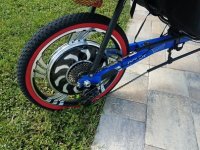casainho
10 GW
- Joined
- Feb 14, 2011
- Messages
- 6,045
So, I found that Cute/Q85 don't have the hall sensors signals spaced at 60 degrees but I am handling it with success - don't known about original firmware.stancecoke said:Are you still testing with the Cute 85? There are several reports, that this motor causes trouble at higher speeds even with the original firmware.
I wounder if this motor have an higher eRPM and that means the hardware have low resolution for that, that get worst at higher speeds...
There is a reason why I am testing with this motor, because it is cheap, small and light. I would say most users go with such motor and so I would like to have firmware working well for it.
I know that I am not doing the PWM scheme as original firmware and I need to do that first. Unfortunately, my original controller with original firmware stopped working and I can't compare anymore. Need to buy another one but may take some time to get it.





